Nokia 2012 Annual Report Download - page 279
Download and view the complete annual report
Please find page 279 of the 2012 Nokia annual report below. You can navigate through the pages in the report by either clicking on the pages listed below, or by using the keyword search tool below to find specific information within the annual report.-
 1
1 -
 2
2 -
 3
3 -
 4
4 -
 5
5 -
 6
6 -
 7
7 -
 8
8 -
 9
9 -
 10
10 -
 11
11 -
 12
12 -
 13
13 -
 14
14 -
 15
15 -
 16
16 -
 17
17 -
 18
18 -
 19
19 -
 20
20 -
 21
21 -
 22
22 -
 23
23 -
 24
24 -
 25
25 -
 26
26 -
 27
27 -
 28
28 -
 29
29 -
 30
30 -
 31
31 -
 32
32 -
 33
33 -
 34
34 -
 35
35 -
 36
36 -
 37
37 -
 38
38 -
 39
39 -
 40
40 -
 41
41 -
 42
42 -
 43
43 -
 44
44 -
 45
45 -
 46
46 -
 47
47 -
 48
48 -
 49
49 -
 50
50 -
 51
51 -
 52
52 -
 53
53 -
 54
54 -
 55
55 -
 56
56 -
 57
57 -
 58
58 -
 59
59 -
 60
60 -
 61
61 -
 62
62 -
 63
63 -
 64
64 -
 65
65 -
 66
66 -
 67
67 -
 68
68 -
 69
69 -
 70
70 -
 71
71 -
 72
72 -
 73
73 -
 74
74 -
 75
75 -
 76
76 -
 77
77 -
 78
78 -
 79
79 -
 80
80 -
 81
81 -
 82
82 -
 83
83 -
 84
84 -
 85
85 -
 86
86 -
 87
87 -
 88
88 -
 89
89 -
 90
90 -
 91
91 -
 92
92 -
 93
93 -
 94
94 -
 95
95 -
 96
96 -
 97
97 -
 98
98 -
 99
99 -
 100
100 -
 101
101 -
 102
102 -
 103
103 -
 104
104 -
 105
105 -
 106
106 -
 107
107 -
 108
108 -
 109
109 -
 110
110 -
 111
111 -
 112
112 -
 113
113 -
 114
114 -
 115
115 -
 116
116 -
 117
117 -
 118
118 -
 119
119 -
 120
120 -
 121
121 -
 122
122 -
 123
123 -
 124
124 -
 125
125 -
 126
126 -
 127
127 -
 128
128 -
 129
129 -
 130
130 -
 131
131 -
 132
132 -
 133
133 -
 134
134 -
 135
135 -
 136
136 -
 137
137 -
 138
138 -
 139
139 -
 140
140 -
 141
141 -
 142
142 -
 143
143 -
 144
144 -
 145
145 -
 146
146 -
 147
147 -
 148
148 -
 149
149 -
 150
150 -
 151
151 -
 152
152 -
 153
153 -
 154
154 -
 155
155 -
 156
156 -
 157
157 -
 158
158 -
 159
159 -
 160
160 -
 161
161 -
 162
162 -
 163
163 -
 164
164 -
 165
165 -
 166
166 -
 167
167 -
 168
168 -
 169
169 -
 170
170 -
 171
171 -
 172
172 -
 173
173 -
 174
174 -
 175
175 -
 176
176 -
 177
177 -
 178
178 -
 179
179 -
 180
180 -
 181
181 -
 182
182 -
 183
183 -
 184
184 -
 185
185 -
 186
186 -
 187
187 -
 188
188 -
 189
189 -
 190
190 -
 191
191 -
 192
192 -
 193
193 -
 194
194 -
 195
195 -
 196
196 -
 197
197 -
 198
198 -
 199
199 -
 200
200 -
 201
201 -
 202
202 -
 203
203 -
 204
204 -
 205
205 -
 206
206 -
 207
207 -
 208
208 -
 209
209 -
 210
210 -
 211
211 -
 212
212 -
 213
213 -
 214
214 -
 215
215 -
 216
216 -
 217
217 -
 218
218 -
 219
219 -
 220
220 -
 221
221 -
 222
222 -
 223
223 -
 224
224 -
 225
225 -
 226
226 -
 227
227 -
 228
228 -
 229
229 -
 230
230 -
 231
231 -
 232
232 -
 233
233 -
 234
234 -
 235
235 -
 236
236 -
 237
237 -
 238
238 -
 239
239 -
 240
240 -
 241
241 -
 242
242 -
 243
243 -
 244
244 -
 245
245 -
 246
246 -
 247
247 -
 248
248 -
 249
249 -
 250
250 -
 251
251 -
 252
252 -
 253
253 -
 254
254 -
 255
255 -
 256
256 -
 257
257 -
 258
258 -
 259
259 -
 260
260 -
 261
261 -
 262
262 -
 263
263 -
 264
264 -
 265
265 -
 266
266 -
 267
267 -
 268
268 -
 269
269 -
 270
270 -
 271
271 -
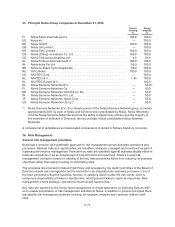 272
272 -
 273
273 -
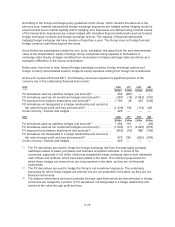 274
274 -
 275
275 -
 276
276 -
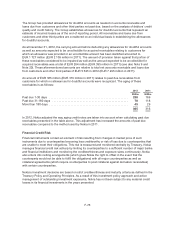 277
277 -
 278
278 -
 279
279 -
 280
280 -
 281
281 -
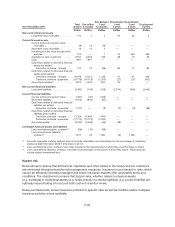 282
282 -
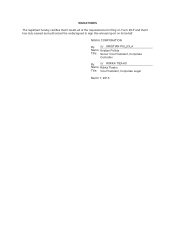 283
283 -
 284
284
 |
 |
(c) Liquidity Risk
Liquidity risk is defined as financial distress or extraordinarily high financing costs arising due to a
shortage of liquid funds in a situation where outstanding debt needs to be refinanced or where
business conditions unexpectedly deteriorate and require financing. Transactional liquidity risk is
defined as the risk of executing a financial transaction below fair market value, or not being able to
execute the transaction at all, within a specific period of time.
The objective of liquidity risk management is to maintain sufficient liquidity, and to ensure that it is
available fast enough without endangering its value, in order to avoid uncertainty related to financial
distress at all times.
Nokia aims to secure sufficient liquidity at all times by efficient cash management and by investing in
short-term liquid interest bearing securities. Depending on overall liquidity position Nokia aims to
pre- or refinance upcoming debt maturities before contractual maturity dates. The transactional liquidity
risk is minimized by entering into transactions where proper two-way quotes can be obtained from the
market.
Due to the dynamic nature of the underlying business, Nokia and Nokia Siemens Networks aim at
maintaining flexibility in funding by keeping committed and uncommitted credit lines available. Nokia
and Nokia Siemens Networks manage their respective credit facilities independently and facilities do
not include cross-default clauses between Nokia and Nokia Siemens Networks or any forms of
guarantees from either party. At the end of December 31, 2012, the Group’s committed revolving credit
facilities totaled EUR 2 250 million (EUR 3 500 million in 2011).
The most significant existing long-term funding programs as of December 31, 2012 were:
Issuer(s): Program: Issued
Nokia Corporation ............... Shelf registration statement on file with the
US Securities and Exchange Commission
USD 1 500 million
Nokia Corporation ............... Euro Medium-Term Note Program, totaling
EUR 5 000 million
EUR 1 750 million
The most significant existing short-term funding programs as of December 31, 2012 were:
Issuer(s): Program: Issued
Nokia Corporation ............... Local commercial paper program in Finland,
totaling EUR 750 million
—
Nokia Corporation ............... USCommercial Paper program, totaling
USD 4 000 million
—
Nokia Corporation and Nokia
Finance International B.V. ......
Euro Commercial Paper program, totaling
USD 4 000 million
—
Nokia Siemens Networks Finance
B.V. ........................
Local commercial paper program in Finland,
totaling EUR 500 million
EUR 82 million
F-78
